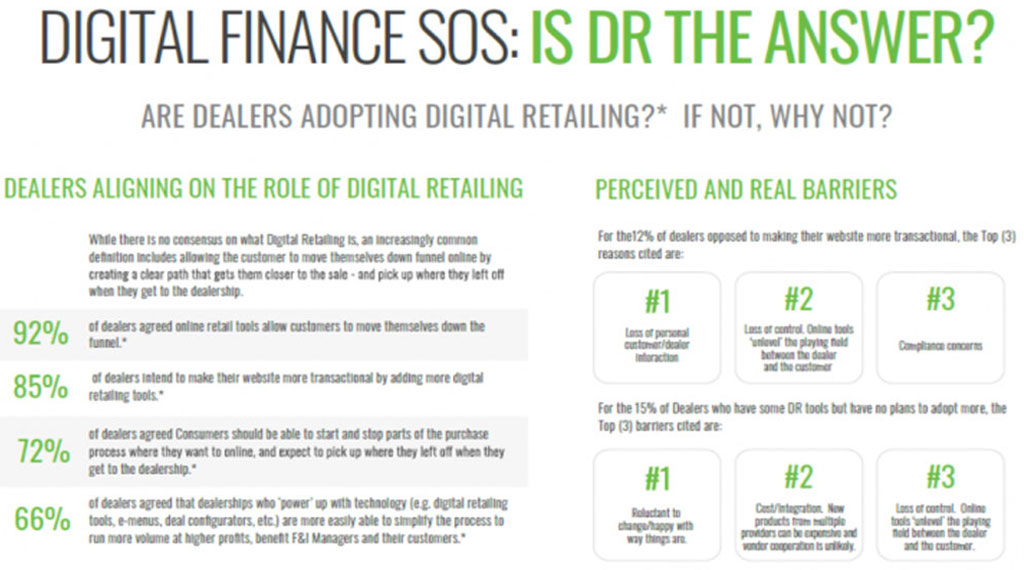
Digital Finance SOS – Is Digital Retailing the Answer? Part Two: Why Aren’t Dealers Adopting Digital Retailing?
By now everyone knows about digital retailing. There are enough automotive technology providers hawking their version of “Retail Magic,” it would be hard to miss it.
At its most basic, digital retail technology empowers car buyers to move through the buying journey online and seamlessly transition in to the dealership. Meaning dealers are able to pick up where customers left off and finish the transaction without process or information duplication. And, according to our recent survey about digital retailing, almost every dealer agrees with that: 92% say that online retail tools allow customers to move down the funnel, and 72% of dealers agreed that consumers should be able to start and stop parts of the purchase process where they want to online – and expect to pick up where they left off at the dealership. Most even agree that it sounds like a solid plan: 85% of dealers intend to make their website more transactional by adding more digital retailing tools.
What’s the Difference Between Knowing and Actually Understanding Digital Retailing?
Knowing about a technology isn’t the same as understanding what it does or how it works. There seems to be a fair amount of questioning over the value digital retailing tools are bringing to dealerships. For example, just 66% of dealers surveyed agreed that dealerships who ‘power-up’ with technology (e.g. digital retailing tools, etc.) are more easily able to simplify the process to run more volume at higher profits and benefit F&I Managers.* That’s a big gap between knowing what it does – and wanting to actually use it. It’s frankly an indication that many dealers have serious concerns about adopting the technology, even though it’s increasingly the preferred way to buy a vehicle. For the 12% of dealers who are actually opposed to making their website more transactional, the top reasons cited are:
– #1: Loss of personal customer/dealer interaction
– #2: Loss of control. Online tools ‘unlevel’ the playing field between the dealer and the customer
– #3: Compliance concerns
For the 15% or so of dealers who have some digital retailing tools but have no plans to adopt more, the top barriers cited are:
– #1: Reluctance to change/happy with the way things are.
– #2: Cost/Integration of new products from multiple providers can be expensive and vendor cooperation is unlikely.
– #3: Loss of control. Online tools ‘unlevel’ the playing field between the dealer and the customer.
Are dealers slow to evolve? Or have they simply seen too many ‘shiny objects’ come and go?
Either way, the message seems clear: dealers hesitate to adopt digital retailing tools because they fear a lack of control over the transaction. Most dealers are reluctant to make serious changes to a sales model that has made them financially successful. Understandably, they are comfortable with the traditional way of selling cars – and many managers only know what they learned before online retailing took over.
Truth is, digital retailing does not remove the salesperson, or introduce chaos to the car sale. The objective of DR technologies is to allow consumers to complete parts of the transaction away from the dealership, facilitate the mutual exchange of information and, most importantly, help dealers sell more cars in less time, while also improving profitability and customer satisfaction.
As great as the technology can be, having the right culture, processes, and people in place for what comes after is so much more important. And because every dealer and transaction are different, a digital retailing plan needs to be flexible enough to best meet the needs of the dealership, their brand, and their customers. As an example, most dealerships will have to make significant changes in order to accommodate the following:
– Determining the right sequence of steps to move people thru the DR experience without losing them
– An increase in active-buyer lead flow, that requires different word/talk tracks.
– Online to in-store integrations and workflows
– Adopting new measurement criteria for leads, engagement, and conversion
– Building a future-oriented sales and management team
- – Ensuring compliance
According to the survey, the potential of Digital Retailing is compelling to most dealers – but many dealers still believe transparency and profitability are in conflict. The key to closing that gap is to focus on the consumer experience, not the technology. Dealers will first need to commit to transparency, then figure out a business model and plan that results in the highest profit from a transparent process. Vendors can help dealers embrace the change by finding solutions to their workflow challenges.
In part three, of Digital Finance SOS – Is Digital Retailing the Answer? we will look into the impact digital retailing has on dealers and consumers. For a summary of today’s numbers, click here.
About The Author
Pete brings 40+ years of experience in automotive finance and technology as Founder and CEO of eLEND Solutions™, an automotive FinTech company providing a middleware solution designed to power transactional digital retailing buying experiences. The platform specializes in hybrid credit report, identity verification, and ‘pre-desking’ solutions, accelerating end-to-end purchase experiences - helping dealers sell more cars! Faster!
Share this:
Recent Posts

